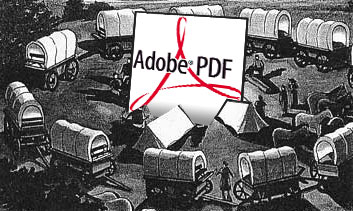Do not base key functionality of your software on closed, third-party libraries - you never know what the future holds.

When Adobe purchased Marcomedia the writing was on the wall for Flashpaper from the outset. Flashpaper was Macromedia's alternative to Adobe PDF for paper-based documents on the Internet. Unlike PDF which requires a dedicated reader application (e.g. Adobe Reader), Flashpaper turns print documents into easily consumable Flash animations. Not only is Flash just as (or even more) ubiquitous as PDF, it integrates better with a user's web-experience. Consequently from Adobe's perspective letting Flashpaper live on as a potentially superior competitor to PDF on the web just did not make sense. Yet whilst this axe has been dangling above Flashpaper's head for quite some time, Adobe has only recently made it official; Flashpaper is dead, long live PDF.
This long coming announcement was a kick in the guts for businesses that have built their products on top of Flashpaper or use it for internal purposes. One bright point was that Scribd took the demise of Flashpaper as an opportunity to establish a competing product called iPaper. Whilst iPaper has some very interesting features (like integrated Google Adwords), it cannot operate 'within the firewall' on documents that are too sensitive for public release. Also iPaper's hosted architecture precludes it from being embedded into third party, redistributable applications.
All of this is a shame from a web developer's standpoint because the ability to render a document (be it PDF, Word or Powerpoint) to a slick looking Flash applet is an excellent piece of functionality. Not only does it reduce system requirements down to a Flash-enabled web browser, the end result integrates better with the browser experience. This integration leads to more possibilities when it comes to viewing and previewing the document beyond PDF's very lame ability consume an entire browser window or frame (not to mention Adobe Reader's poor load times).

The really sad part about this is that it seems Adobe is going to put Flashpaper out to pasture and simply lock-up or destroy the source code. If the product did not threaten PDF so directly it would have been a great opportunity for the company to gain some open source kudos by releasing the underlying code to the Flashpaper community. No doubt if this were to occur within twelve months there would be Flashpaper implementations in Java, .Net, Ruby, PHP and Perl. Ultimately this would have been a great thing for the industry and resulted in more Flash-content creation. Instead by circling the PDF wagons Adobe has chosen to wipe out what could have been an industry changing piece of technology in favour of some short term profits.
Unfortunately for Adobe I am sure Microsoft will not hesitate to add similar functionality to a rapidly maturing Silverlight. As a result in a few years do not be too surprised to see many sites offering Silverlight-based document viewers made possible by Microsoft-blessed (and powered) back-end tools. It will be at the point when this Silverlight-centric document future starts taking hold that Adobe execs will rue the day they terminated Flashpaper, effectively handing the 'paper web' to Microsoft.
